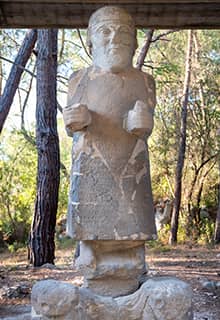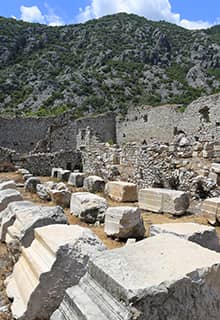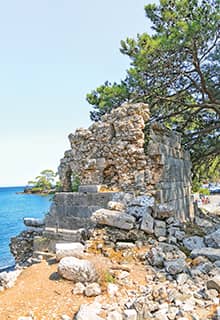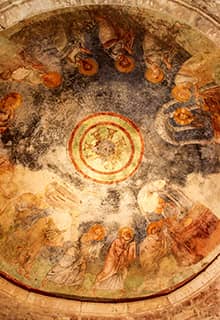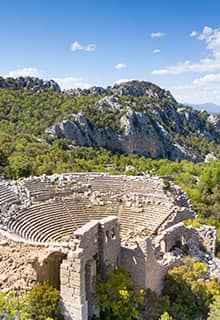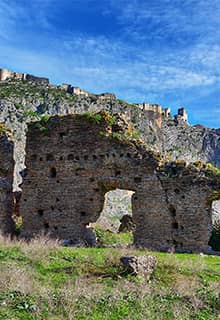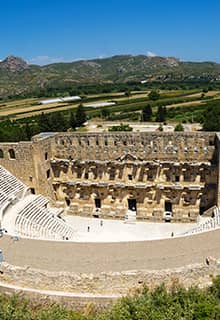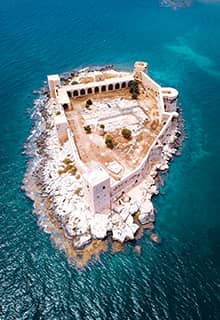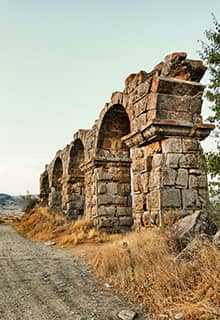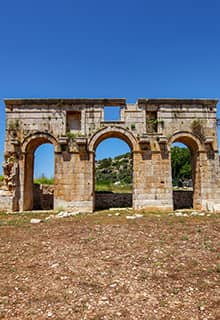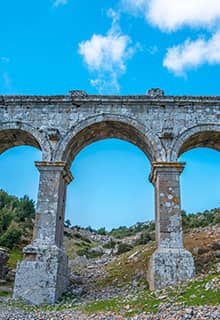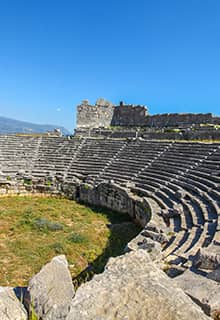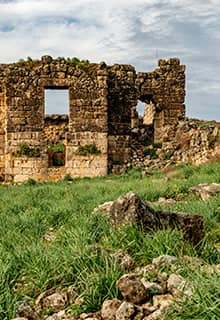

historical sites Mediterranean
Türkiye
Anazarbus, Adana
Anazarbus is a Cilician city known during the period of the Roman Empire as Kaesarea, it is located 30 km. south of Kozan, close to Seyhan, Adana. The place is called Anavarza today. It can be easily reached from Adana and suitable for a day trip. One should be prepared for a steep climb after visiting the ruins scattered around the modern village of Ayşehoca, as the medieval castle on the top of the hill is worth visiting with the remains and the magnificent view of Çukurova Plain that dominates the whole area. Bearing the cultural traces of various periods such as Hellenistic, Roman, Medieval, and Ottoman, the city is on Tentative List of UNESCO World Cultural Heritage.
Andriake, Antalya
Andriake was the ancient port of Myra, located 10 km west of Demre. Today it still is a port for visitors who embark boats to visit the sunken city of Kekova. Recent excavations carried out by Turkish archaeologists gave the city once again the look of a harbor. The agora and the great cistern under the agora were renovated, a wooden ship model is placed in the harbor and the monuments around the harbor and agora were all excavated and restored. The “Horrae”, ancient granary, that was preserved except the roof, was restored, and now serves as the Lykian Civilizations Museum. Also, the only known synagogue in Lykia was discovered here.
Ariassos, Antalya
Ariassos is one of the most attractive cities of ancient region of Pisidia. It is located some 60 km. north of Antalya and it is just 1 km off the main road from Antalya to Bucak and therefore easy to access. As you enter the ancient city, a remarkable monumental gateway, known as the Triumphal Arch welcomes you. A Triumphal arch is dedicated to a Roman emperor over his victories in war. There were statues erected on the top, and according to the inscriptions, they refer to the emperor Severus Alexander who defeated the Persians in campaigns in 3rd century BCE. As you walk further north, remains of a Roman bath and several monumental tombs can be seen. Pisidians decorated their cities with tombs unlike the ancient Greeks who used cemeteries usually outside the cities. One can also visit the theater and civil center of the city and enjoy the great views over the Anatolian landscape. Those who have enough energy and time, can also explore the ancient road north of the city.
Arykanda, Antalya
Arykanda is a city located next to the steep hill of the Tauros mountains which offers great natural landscape and a magnificent setting of an ancient city. Arykanda is in the beautiful valley called Arykandos, or Aykırtca, a place of profound beauty and serenity among the pine and cedar trees. It can be reached via the main road leading from Finike to Elmalı, it is 35 km to Finike, and 150 km to Antalya. Arykanda is known to be one of the old Lykian cities, as its name ends with -anda, indicative of its Anatolian origin; dating back as far as the 2nd millennium BC. The city has been well excavated by Turkish archaeologists since 1969, and a great part of the city is unearthed. Including a great bath, perhaps the biggest in Lykia, there are total of 4 baths. The visitor first encounters the great monumental temple tombs, unique to this area, as the Lykians deified their heroes burying them in Temple Shaped Tombs. The city has a state and a civil agora, a theater, Odeon (concert hall), a bouleuterion (parliament building) and remains of houses and villas. Especially the theater has a wonderful location. Above the theater stands the stadion, one of the best examples from the ancient world. After the visit to Arykanda, one can enjoy the local market near the water springs and Lykian rock cut tombs.
Aspendos, Antalya
Aspendos ancient city is located 40 km East of Antalya, quite easy to reach, on the River Eurymedon in ancient times, today known as Köprüçay. Eurymedon was a famous with The Battle of the Eurymedon in history as the first battle, taking place both on water and on land, in the 5th century BCE. The theater of Aspendos is not only the best-preserved theater of the Roman period, but also the best designed theater of the same period. The Seljuk Turks renovated the ancient theater about a thousand years later it was built, to use as a caravanserai and a palace, and this renovation helped the theater reached our days almost intact. The only example of an ancient theater where the stage building is still standing to its original height, just the statues in the niches are missing. One should also take her/his time to walk up to the city and see the great basilica, agora, the fountain and the aqueducts and siphon systems of the city which are also unique.
Kandyba, Antalya
Kandyba is a remarkably interesting Lykian city, just 25 km from the picturesque resort town of Kaş, and worth a visit especially in the spring to enjoy the flowers as well as the ancient city and the traditional village of Gendiye. Although the city has never been excavated and not much to see, as it is in a traditional local village. Ruins and the village make a perfect harmony. One can also enjoy the local wooden storages copied from ancient Lykian houses and tombs, still in use.
Myra, Antalya
The ancient city of Myra in Lykian, gets its name from the myrrh plant, as in “ frankincense and myrrh” in historical texts. Myra, is located 140 km to the west of Antalya city and today the town is called Demre. The city can be reached via the coastal road from Antalya to Fethiye with spectacular views. The visitor is welcomed with the magnificent view of the Lykian Rock Cut Tombs, located within citrus orchards and next to the great theater from the Roman Period. Ancient theaters were dedicated to Dionysos, and Dionysos often went to the underworld to visit his mother Semele. Lykian made a perfect sense of this mythological story by building their tombs and the theater next to each other. The tombs are mostly in “house type”, where wooden Lykian houses were imitated on rock, some of them have reliefs that still can be seen clearly. The ancient theater is also very well preserved and recent excavations revealed that this was built over an existing Hellenistic theater. One can see the chapel that is also recently excavated just outside the theater. Adventurous visitors should also visit the acropolis hill, for the sake of the early walls, ancient steps climbing up to it and the magnificent view of the Demre plain. The second great necropolis of Myra is on the eastern part of the Demre valley, rarely visited by anyone, however, there are also beautiful tombs and reliefs in this area. One must be careful as there are no steps or railing to climb these tombs.
Church of St. Nicholas, Antalya
“At the west edge of the village of Demre is the famous church of St. Nicholas of Myra, the goal in former times of pilgrims, now of tourists.” writes Prof. George Bean in his book “Lykian Türkiye”. Born in Patara about 300 CE, became bishop of Myra; famous for the miracles he performed, he was the patron saint of Greece and Russia, as also of children, merchants, sailors, and scholars. Sceptics have indeed questioned his very existence. We need not doubt that he lived and died at Myra. The church dedicated to Nicholaos has been excavated by Turkish archaeologists, a roof to protect the structure was added. The tomb of the Saint is located inside the church and has Cyrillic inscriptions on it, carved during the restorations carried out by the Russians back in the 19th century. The tomb was opened, and the relics of the Saint was taken to Italy, Bari in the 11th century, where relics of the Saint are kept both in Antalya and Bari museums.
Olympos, Antalya
Olympos is located some 80 km southwest of Antalya, within the Olympos Beydağları National Park. The city is especially important as it is hosting the Olympos Mountain in Lykia, known as “Musa Dağı” today. Archaeological research indeed revealed several shrines dedicated to Hephaistos, the black smith god on Mount Olympos hence it’s relation with neighboring Chimera. The city is located at the famous Olympos beach, subject to visitors from all over the world all year around. The Lykian Way, the great walking trail in Lykia, also passes through this ancient city. The ancient harbor and monuments scattered on either side of the ancient harbor, gives the city a magnificent view. The city has a theater, remains of a bridge, an Imperial temple, unfinished but quite impressive with its façade, several tombs and late ancient buildings from early Christian period. The thick laurel bay trees that surrounds the city give the city a very exotic look.
Patara, Antalya
Four of the six most important cities of Lykia are located along the Homeric Xanthos valley, Tlos, Pınara, Xanthos and Patara from north to south. Patara can be easily reached from main airports like Dalaman and Antalya. Patara’s excellent location as a harbor, and the myth as being the birthplace of Apollo, gives the city a unique importance. The city was first mentioned in the Hittite texts as Patar, became Patara in Lykian language and was called Patara during the Roman period. The successful excavations and restoration work carried out by Turkish archaeologists since 1990, revealed much of the city from the sand carried by huge waves from its marvelous beach. Patara was the capital of Lykia during the Roman period and the center where the Lykian League was assembled. Lykian League is the first modern type of democracy, where Lykian cities were represented proportional to their population and influenced contemporary nations through Montesquieu, who defined the Lykian League as the best example for ancient democracy. The Bouleuterion, where the Lykian League was gathering, is restored in a perfect way. The city hosts four great baths, a monumental arch, a magnificent theater, several tombs and the only surviving example of an ancient “Paros”, a lighthouse. It was also the birthplace of St. Nicholaos who served as a bishop in the neighboring city of Myra.
Perge, Antalya
Perge lies some 20 km East of Antalya, on the main road to Alanya. The origins of the city go back to the bronze age, it was called “Parha near river Kaastra” during the Hittite period, became, Perge near the Kestros River in Greek times. The city has been successfully excavated by Turkish archaeologists for over 70 years, and Antalya Museum holds all the magnificent statues unearthed from Perge. Thanks to the excavations and restoration works, the city offers extensive visit of the theater, stadion, city walls, baths, agora, and the colonnaded street which gives the feeling as one is walking through the streets of an ancient city. It was an important harbor of the Roman Imperial period and became very wealthy during this period. As you enter the city through, he late Roman gate, a broad square welcomes you, with Hellenistic towers dominating this square. Immediately on your left, stands the magnificent fountain attached to the baths. The baths of Perge are one of the best examples of the Roman Period baths. You can walk through the colonnaded street, enjoy the water channel that was built in the middle to provide fresh water and cool air, see the shops and civil houses on either side of this street, and walk all the way up to the acropolis to enjoy the view.
Phaselis, Antalya
Phaselis is located some 70 km south-west of Antalya, reached by a scenic coastal road. It was the last city on the Eastern border of Lykia, colonized by people from Rhodes in the 7th century BCE. The city is very picturesque with its three harbors, still can be seen today, one can enjoy crystal clear waters to swim in any of these ancient harbors above the ancient pier. The first monuments that welcome you are the monumental tombs, and the great view of the military harbor. You can see the aqueduct system once carrying water to the central baths of Phaselis. You walk from the main street to reach the agora, agora building and the small theater which is in a particularly good preservation. You can continue to the south harbor, passing the remains of a monumental gateway built during the time of Emperor Hadrian. From the south harbor you can also enjoy the great view of “Solyma” Tahtalı Mountain that dominates the city.
Sagalassos, Antalya
Sagalassos is located some 120 km North of Antalya, on the way to Isparta. The area is especially beautiful as the Lake Eğirdir, one of the lakes of the Lake District of Türkiye is remarkably close and a visit to Sagalassos with Eğirdir, should also include a visit to Burdur Museum where all the wonderful pieces of statues and friezes are on display here. Excellent excavation and restoration work that took place in Sagalassos since 1989 makes the ancient city a remarkable visit. Today, Sagalassos meets visitors with its beautifully decorated ancient fountain where one can still drink the water from its ancient pools. The Anatolian origins of the city is related with Luwian Salawassa, and the city prospered during the Hellenistic and Roman Periods. It was the 2nd important city in Pisidia with Termessos and played an important role in the Pisidian history. The city offers a great bath, the lower and upper city remains, where the lower city has the good examples of fountains and colonnaded street. The upper city and the state Agora are a gem with the restored fountain from the Roman Imperial period. The Heroon with the dancing girl’s frieze, the Bouleuterion, “Macellum”, which can be translated as the market for valuable goods and the theater dominates the upper city. One should also make a visit to Dionysos Temple and the rock-cut tombs, peculiar to Pisidia. As the city is located on an exceedingly high altitude, almost 1500 meters above the sea level, one must be careful visiting the city in the winter due to possible heavy snow. On the contrary, it is a wonderful place to visit during the summer when it is almost always nice and cool.
Lyrbe / Seleucia (Pamphylia), Antalya
Lyrbe in Pamphylia is a wonderful, but rarely visited and known ancient city. A recent road enables visitors to reach Lyrbe easily, some 20 km north of Side. The Turkish excavators who worked in Side, also excavated Lyrbe. The agora building is almost intact and attached to the agora one can see the remains of an exedra and a library. Lyrbe was probably a city founded by Side, or, vice versa, and was perhaps used to keep the treasures of Side, which was on the coastline and open to piracy, while Lyrbe is on the mountains and well protected. The pine forests that surround the entire city give Lyrbe a very picturesque view.
Selge, Antalya
Selge is located 120 km northeast of Antalya and offers not only a visit to an ancient city, but also grants with the visit of Köprülü Canyon National Park. One may try to have some spare time to enjoy white water rafting on Köprüçay, the ancient Eurymedon while visiting Selge. Selge was a Pisidian city, located in the mountains, as we know from ancient texts that it was prosperous especially with olive oil production and several herbs that grow in this area. The ancient city is still accommodated by local villagers, and it is interesting to observe the locals living today on top of the ancient stadion, theater, and agora. As you enter the city, the agora and the local village houses welcome you where you may stop to taste the local herb tea, enjoy “gözleme”, a local type of pastry that villagers still make. Ancient stadion, theater, and agora are all located in the lower part of the city. One must make a short walk, uphill to see the state agora, odeon (the concert hall), the colonnaded street and wonderful cypress forests that only exists in this area.
Side, Antalya
Side, meaning pomegranate in local Anatolian Luwi language, is a lovely resort on the Mediterranean. The village, Selimiye is a small tourist town full of ancient monuments and a beautiful harbor. Side is 70 km East of Antalya and can be reached throughout the year easily. This area where Antalya, Perge, Aspendos and Side are located is called Pamphylia, and it is the only ancient geographic region in Anatolia bearing a Greek name. All the other ancient areas such as Pisidia, Lykia, Karia etc, are in Anatolian Luwian language. Pamphylia means “the land of all tribes”, and indeed it was a mixture of several different peoples, and their language was mixed up with the local languages and the outcome was “Side” dialect which was a mixture of all. Recent excavations in Side made the town quite interesting, several ruins, shops, hotels, restaurants are all mingled up and it makes you feel you are walking in wonderland. Side museum, converted from the ancient bath, contains beautiful sculptural pieces from Side, marking cities wealth and prosperity especially during the Roman Imperial period.
Sillyon, Antalya
Sillyon is another ancient city along the Pamphylian Plain, however, more difficult to reach and visit comparing to cities like Perge and Aspendos. Sillyon is located 35 km East of Antalya and you can reach driving through picturesque villages. The only two cities which Alexander the Great was not able to capture were near Antalya, Termessos is one of them and Sillyon is the other. Seeing the remarkable fortifications of the city still standing to sufficient height will make you realize why. Climbing to the acropolis is not easy and taking a local guide from Antalya will be better. Once you are at the top, you will notice several buildings from Hellenistic to Byzantine periods, however the most interesting structure is the ancient theater. The upper seats of the theater are on the hill, while the lower seats are down at the bottom of the cliff, as the cliff cracked and fallen, the theater seats went down with them.
Termessos, Antalya
Termessos, is perhaps one of the most attractive ancient cities not only in Türkiye, but all over the world. The Güllük Dağı National Park adds a lot to the beauty of this place. Termessos can be reached easily from Antalya driving 35 km North West along the Denizli – İzmir road. As the “ss” within the name suggests, it was one of the Luwian originated cities, the people of Termessos even went further and noted that “we are neither Pisidian nor Lykians, but we are Solymians” referring to their sacred mountain Solymos (Güllük Dağı) Mountain, where the main deity of the city was also called Zeus Solymeus. Alexander the great failed capturing the city so burnt its olive orchards and continued his campaign as we here from Arrianos. Indeed, it feels like the city is located on an eagle’s nest, fortified with impressive fortifications, almost impregnable. As there were no modern settlement nor roads leading up the city until recently, most buildings are almost intact, gives the visitor a strong feeling as if the blocks just tumbled down yesterday. One must have at least four hours, better all day to visit the city, as Termessos is huge, there are 4 cemeteries with beautiful examples of Pisidian tombs with several reliefs in almost excellent condition, Theater with an amazing view of Mount Solymos, Bouleuterion from the Hellenistic period standing to its original height, very impressive cisterns and water systems, temples, baths, colonnaded streets and obviously the impressive landscape and forests.
Xanthos, Antalya
“I came all the way from distant Lykia, from the eddying Xanthos river” says Sarpedon, the Lykian hero in the Iliad. Indeed, Xanthos was the capital city of Lykia in the early Lykian times. The city committed mass suicide at least two times in his history instead of surrendering to the enemy. One at 546 BCE, during the Persian invasion, and 2nd time during the 1st century BCE when Brutus came to Lykia to gather forces. The evidence of the glorious days from the 4th and 4th centuries BCE, decorates the whole city. As a typical Lykian tradition, the city center is decorated with beautiful Lykian tombs, most of them with reliefs and inscriptions both in Lykian and Greek. Unfortunately, much was taken from Xanthos during the 19th century, when Sir Charles fellows came to Lykia and carried dozens of boxes full sculptural pieces. Today, Xanthos room in the British museum holds the material that was taken from Xanthos. A visitor to Xanthos somehow feel the sadness of the city, once stood as a magnificent city on the Xanthos Valley, is now in its solitude. Xanthos River just flows next to the city and the view from the acropolis is outstanding. Visitor first arrives to the city gate, as you walk to the agora, you can see the foundations of the “Nereids” monument which in England. Once you arrive to the agora, peculiar Lykian Tombs welcome you along the agora and the theater. East of the theater is the Lykian acropolis, and across from the theater you can enjoy the colonnaded street, one of the biggest Basilica Churches in Lykia, and a walk further will take you to the North necropolis where best examples of Lykian tombs can be seen.
Kremna, Burdur
Kremna is located near the lake district, some 90km North of Antalya. From Antalya, drive to Bucak, and turn East following the signs to Kremna, or Çamlık village. The city was mainly established during the Roman period, and perhaps there was a small settlement here before that. Kremna had become a Roman colony; that is, it received a settlement group of veteran soldiers from the emperor Augustus whose families now become the dominating social group in Kremna and in the 2nd century CE, under the emperor Hadrian that large scale city buildings appear. The city gate welcomes the visitor as you approach the city through a pleasant old path, and once you enter the city, remains of impressive buildings lie everywhere. The buildings that are visible are the remains of a bath, agora, propylon -monumental gate-, colonnaded street and fortifications with a deep mound. In the agora there is a peculiar block with inscriptions: this rectangular pillar is one of the most fascinating monuments from Kremna. it is a dice oracle; it contains a series of more than 60 texts in Greek, each attached to a number, and the number represents the throw of five dice - ancient dice or astragals, ancient knucklebones, and you threw five dice, you looked at the numbers you came up with on your throw. Kremna also provides a magnificent view, especially towards North, and the sculptural work discovered here are on display in Burdur Museum.
Hacılar, Burdur
Hacılar is one of the earliest Neolithic Mounds in Türkiye with Catalhöyük. In 1956, villagers at Burdur showed James Mellaart some unique sherds of pottery that had apparently come from a mound near the Hacılar Village, about 25km west of Burdur. The dates of the pottery which had been discovered, provided evidence for a link between the pre-history of Syro-Mesopotamia and Greece and the Balkans. The painted pottery was decorated with patterns, and select pieces were mended and delivered to the Ankara Museum. Taken together, the material points to the settlement beginning sometime in the late Neolithic period and continuing uninterrupted until the Early Chalcolithic. The significance of the Hacılar excavations lies in the fact that the site was “earlier than any settlement known in Türkiye at that time and yielded the first information about Neolithic and Early Chalcolithic culture in Asia Minor” A visit to Hacılar will be completed with Ankara and Antalya Museums.
Kibyra, Burdur
Kibyra lies North of Lykia, and was the provincial capital of Cibyratis region, a confederation of towns that was created in the 2nd century BCE. It was formed by four cities - Kibyra, Boubon, Balboura, and Oinionda.
Strabo, the Greek geographer, claimed that the residents of Kibyra were the descendants of the Lydians, the indigenous people of this part of Asia Minor. It is known that four languages were used in the federation as its members spoke Lydian, Greek, Pisidian, and Solymi. Kibyra was the last place in Anatolia, where the traces of Lydian culture, long forgotten in other parts of the region, could be found. An important source of income for the residents of Kibyra was metallurgy. The city minted its coins from the mid-first century BCE until the reign of Emperor Gallienus i.e., the middle of the third century CE.
After the Roman conquest, Kibyra was still a major town in the region. Its importance was strengthened by the location at the crossroads of important routes, on the border between Karia, Lydia, Phrygia, and Pisidia. Most of the buildings preserved in the ancient city were erected in the Roman times, and more precisely - after 23 CE when the city was destroyed by an earthquake.
Successive Roman emperors provided the assistance with the reconstruction of the city. Emperor Tiberius exempted Kibyra from taxes for three years. The reconstruction was also encouraged by Emperor Claudius, and the grateful people of the city added Caesarea to its name. They also initiated the organization of the games and started dating a new era from the year of 25 CE. Emperor Hadrian, while travelling through the eastern provinces of the Empire, arrived in 129 CE to Kibyra and granted many privileges to its inhabitants.
Another earthquake hit Kibyra in 417. This time, because of unfavorable economic conditions, the city could not be entirely rebuilt. The territory of Kibyra gradually shrank until the last residents left the city in the eighth century. They moved to the settlement of Horzum, that is now known as Gölhisar.
Antioch, Hatay (Antiocheia)
Antioch is situated on the Eastern Mediterranean, close to the Syrian Border. The modern city of Hatay, has always been home for various cultures and civilizations. It was established by the Seleucid Kings of Syria. After the unexpected death of Alexander, The Great, his successors fought with each other to gain control over his empire, and Syria was controlled by the Seleucids, and Antioch was established by Seleucus I. Nicator around 300 BCE. It was an important city during the early history of Christianity, in particular that of the Syriac Orthodox Church and the Antiochian Orthodox Church. St. Peter, also known as Simeon, was on the disciples of Christ and one the earliest Christian Churches was built in Antioch for St. peter, where is still a place for pilgrimage. The Titus tunnel recently excavated Roman Vilas with wonderful mosaics, Vakıflı Village and Daphne, the ancient residential area where several villas were excavated are some of the interesting places to visit. The mosaic floors that were discovered in these houses are displayed in Antakya – Hatay Museum. Daphne, or Harbiye as it is called today, also famous for wonderful restaurants of this gourmet town.
- Issus, Hatay
- Myriandrus, Hatay
- Rhosus, Hatay
- Seleucia Pieria, Hatay
- Tell Tayinat, Hatay
- Domuztepe, Kahramanmaraş
- Anchiale, Mersin
- Antiochia Lamotis, Mersin
- Aphrodisias of Cilicia, Mersin
- Arsinoe, Mersin
- Aulai, Mersin
Corycus, Mersin (Korykos)
Along the coastline of east Mediterranean, Mersin – Adana area is full of ancient monuments, perhaps the most appealing one is Korykos, “Kızkalesi”, maidens tower today. The ancient city is at 65 km from Mersin. The city lies alongside northeast and southwest reaching Elaiussa-Sebaste at the east and Hell-Heaven Caves at the west. We hear from Herodotos that the city was founded by a Cyprian Prince named Korykos, one of several cities established by this king. The ancient city is excavated in recent years and several of the monuments are unearthed including a theater. The most attractive part are the two castles, one on the sea and the other on land. The beautiful sandy beach makes a visit to Korykos enjoyable.
- Elaiussa Sebaste, Mersin
- Emirzeli, Mersin
- Epiphania, Mersin
- Gözlükule, Mersin
- Kirshu (Meydancık Castle), Mersin
- Küstülü, Mersin
- Mamure Castle, Mersin
- Anemurium
- Mezgitkale, Mersin
Olba, Mersin (Diocaesarea)
Diocaesarea is perhaps the most attractive ancient city in Cilicia. Cilicia is the ancient region that covers almost entire Eastern Mediterranean and the Eastern Taurus Mountains. It is located some 70 km North West of Mersin, and a very scenic winding road reaches to the ancient city. The great Hellenistic tower called “Uzuncaburç” gives is modern day name. The early city is located somewhat 6-7 km to the East of Uzuncaburç, during the Roman Period, the city is re named as Diocaerarea and moved its present place with wonderful monumental buildings added. The most interesting is the temple of Zeus Olbios, a local god and this Corinthian temple is the earliest known Corinthian orders in Anatolia. Besides the temple and the Hellenistic tower, one can visit the theater, the temple of Nike, the monumental gateway, and the interesting pyramidal tomb.
- Soli, Mersin
- Tapureli, Mersin
- Tokmar Castle, Mersin
- Yeniyurt Castle, Mersin
- Yumuktepe, Mersin
Antioch, Pisidia Isparta
There are several ancient cities bearing the name Antiocheia, after Macedonian King Antiochos, and the one in Pisidia is located at modern day Yalvaç, 110 Km from Isparta. The, importance of the city mainly from the visit of St. Paul, and the city is accepted as a pilgrimage place. Augustus temple, aqueduct systems, ancient theater and recently excavated streets are worth seeing. The Men (moon god) Temple is located about 10 km north of the city on a hill with great view.
- Seleucia Sidera, Isparta
Karatepe, Osmaniye (Aslantaş National Park)
Karatepe, Aslantaş National Park has a very scenic road from Adana, some 130 Km to North East of Adana. Karatepe is a fortified hill above the Ceyhan River in Cilicia. The Karatepe-Aslantaş fortress date back to the late 8th or early 7th century BCE. Karatepe-Aslantaş is one of the latest archaeological sites where the Luwian language inscriptions have been discovered. In the 12th century, the Hittite Empire had collapsed and left behind a series of smaller kingdoms, scattered in the area of southeastern Asia Minor, mainly around Gaziantep, Malatya, and Osmaniye. The ruins today are remarkable, thanks to the Turkish archaeologists, almost all reliefs and inscriptions were preserved in their original preservations. Especially the view of the Dam from almost every part of Karatepe, makes the visit extraordinary.


